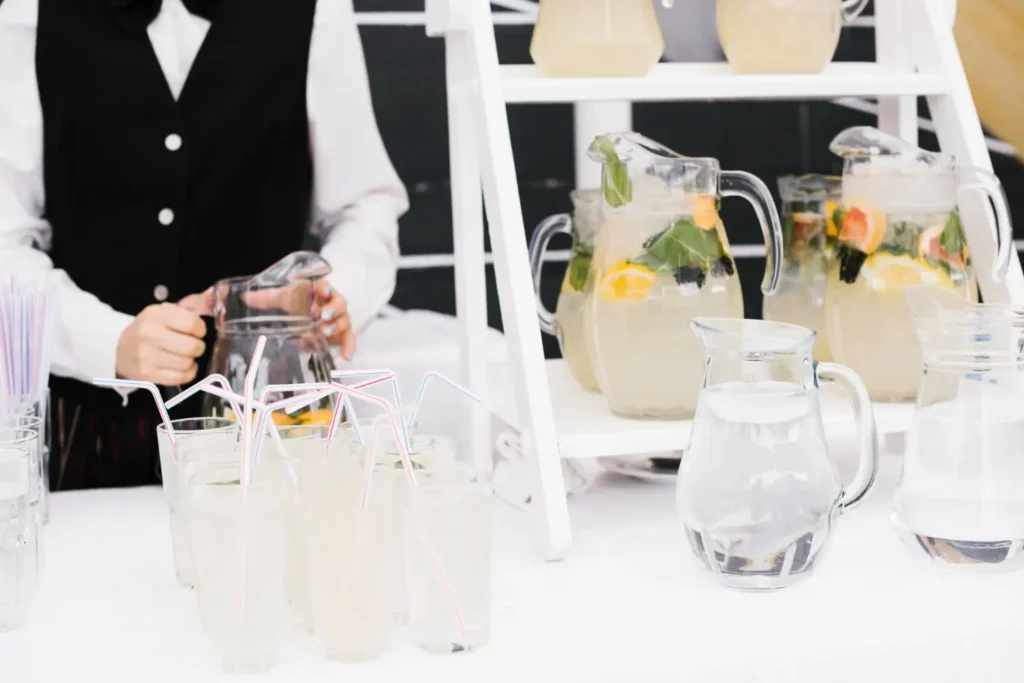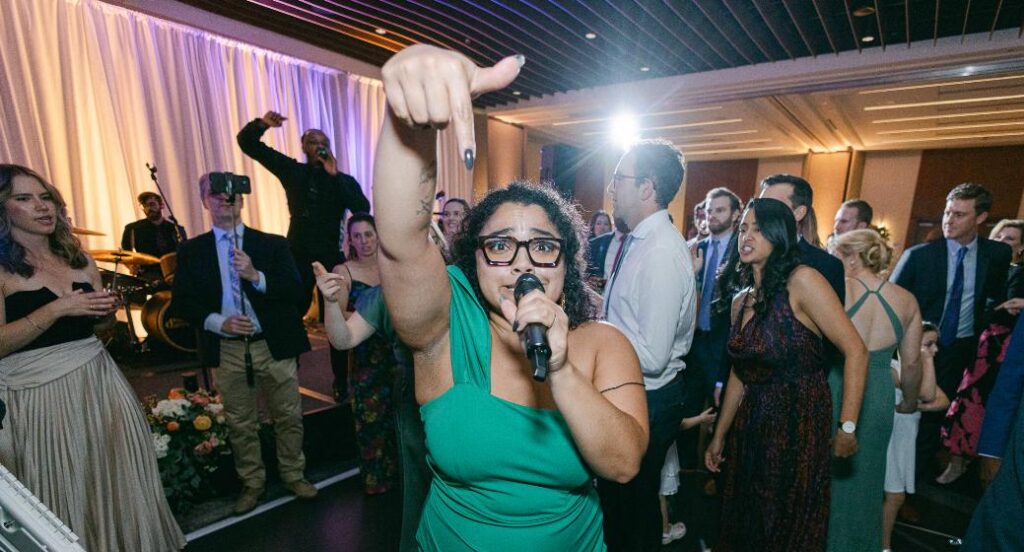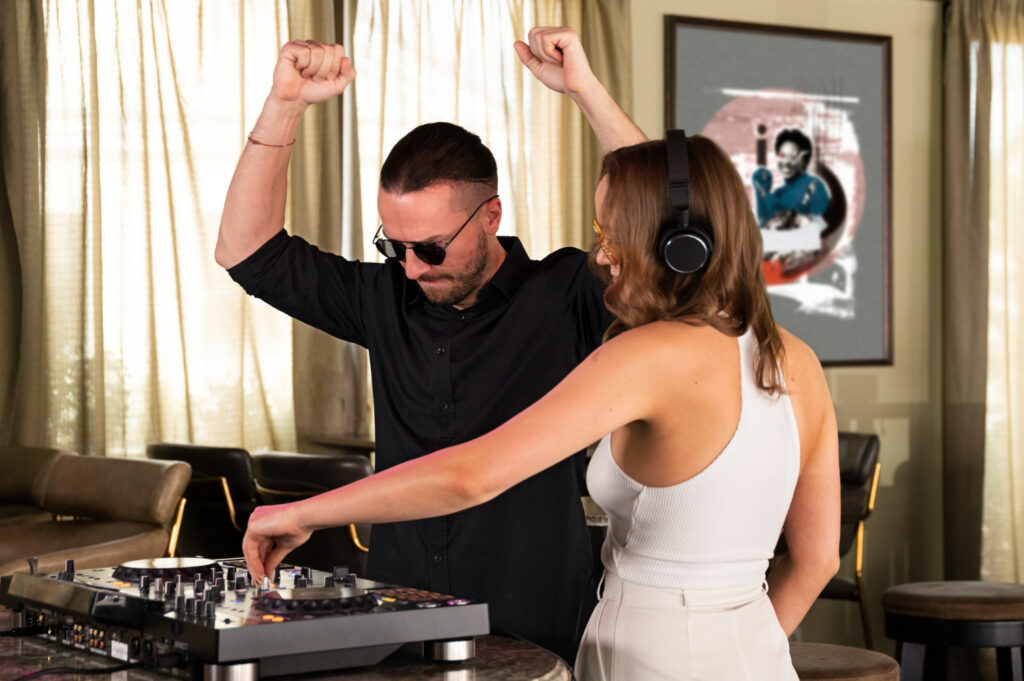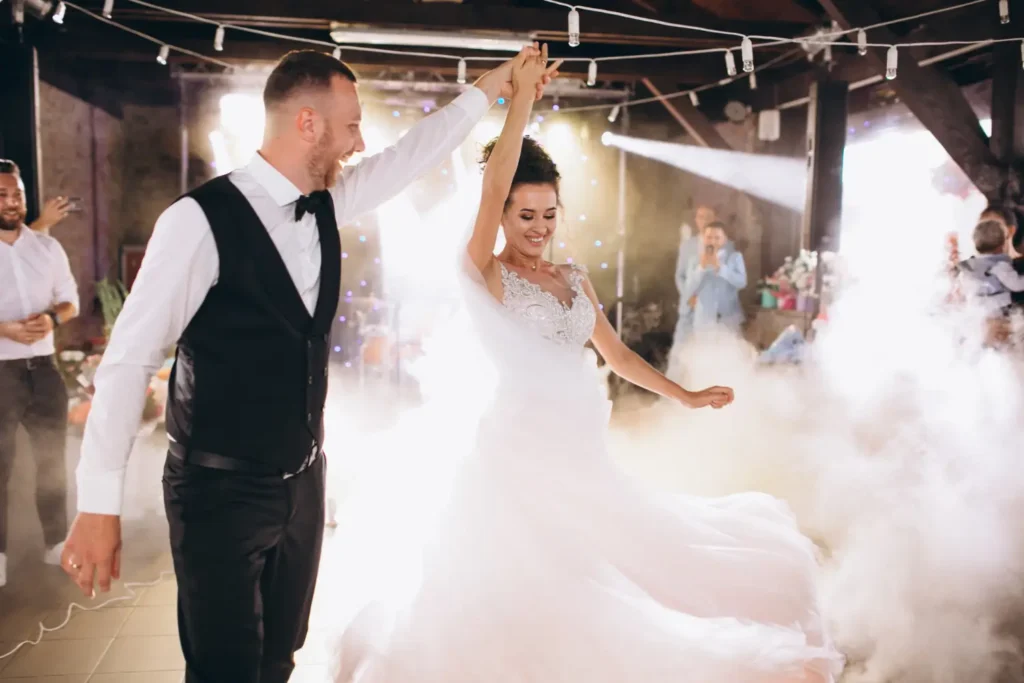How long should a wedding playlist be
I’ve managed wedding bands since 2007 and have seen how quickly a dance floor can lose its spark when the music runs out. The length of your playlist truly sets the mood for the entire night.
It’s more than just having enough songs. Your playlist shapes each part of the wedding. If there’s not enough music during cocktail hour, guests might drift away or start checking their phones. If dinner music stops too soon, everyone notices the sudden quiet. On the flip side, a dance playlist that goes on for hours can wear everyone out, even your most energetic friends and family. The trick is to match your music to your actual timeline, making room for toasts, surprise speeches, and those last-minute song requests.
Finding the right playlist length takes both planning and a little creativity. It depends on your schedule, the style of your celebration, and how you want the energy to flow. After years of playing everywhere from Boston ballrooms to backyard tents, my advice is to think through each part of the day and leave a little extra time in your playlist. This way, you’ll avoid running out of songs or ending the fun too soon.
Understanding Your Wedding Timeline
Weddings are each feel unique, but most follow a similar schedule. There’s the ceremony, a relaxing cocktail hour, dinner, and then the big dance party at the end. Figuring out how much music you need for every section is what keeps the night smooth and the energy up. From my experience managing playlists for many weddings, matching the right songs to the right moments is key. It’s not just about picking favorites, but making sure your playlist fits each part of the evening.
| Wedding Segment | Traditional Wedding | Short Wedding | Extended Celebration |
|---|---|---|---|
| Ceremony | 30 min | 15 min | 45 min |
| Cocktail Hour | 60 min | 30 min | 90 min |
| Dinner | 90 min | 60 min | 120 min |
| Dancing | 120 min | 60 min | 180 min |
Ceremony and Cocktail Hour

The ceremony usually moves quickly. You’ll want about three to six songs – enough for the processional, maybe a moment in the middle, and the exit. Some ceremonies wrap up in just 15 minutes. Others, with more readings or traditions, can last up to 45. After the vows, the cocktail hour begins. Plan for an hour of background tunes, which means about 10 to 15 songs. This sets a relaxed mood while guests chat and you take photos. Even though it might seem like background noise, having music here prevents the room from feeling empty or awkward.
Dinner and Dancing
Dinner usually lasts around an hour to an hour and a half. You’ll need roughly 10 to 15 songs, aiming for something lively but not overpowering. After dinner, it’s time for dancing. This is the longest music block, sometimes running two hours or even longer. Expect to fill this part with 20 to 25 songs, depending on your crowd. The goal is to keep the dance floor busy and guests happy, from the first slow song to the final singalong. A well-timed playlist keeps the celebration moving and makes sure no one has a chance to lose interest.
Calculating the Perfect Playlist Length
There’s no magic number for every wedding, but there is a simple way to figure it out. Most songs run about three to four minutes. Multiply that by the number of hours your celebration will last, and you’ll get a solid starting point.
Let’s say your dance floor is open for two hours. You’ll need around 25 to 30 songs just for that part. Remember to include music for your ceremony, cocktail hour, and dinner. Those extra segments add up fast. Also, leave some room for transitions and breaks. These moments help avoid gaps and keep everything moving smoothly.
Quick Checklist for Playlist Length:
1. Total event hours (guest arrival to last dance)
2. Number of event segments (ceremony, cocktail hour, dinner, dancing)
3. Minutes per segment
4. Multiply minutes by average song length (3–4 min each)
If you like having exact numbers, here’s an example: For a five-hour event (about 30 minutes for the ceremony, 1 hour for cocktails, 1.5 hours for dinner, and 2 hours for dancing), plan on 50 to 60 songs. It’s always smart to have more than you think you’ll need. Skipping a song is easy if the mood shifts, but scrambling to find more music is stressful. A well-planned playlist keeps the party moving and helps everyone make the most of your celebration.
Real Wedding Examples
Every wedding has its own rhythm, and the playlist needs to match. Take a Cape Cod wedding that comes to mind each summer. The couple wanted a relaxed, coastal atmosphere, and their timeline included an extra-long cocktail hour out on the lawn. Their music plan covered an hour for cocktails, two for dinner, and almost three for dancing. That added up to nearly six hours of songs. We prepped more than 90 tracks, blending classic yacht rock with easygoing pop. The energy never faded. Every moment felt fresh, right up until the lights came on.

Now compare that to a Boston wedding held at a historic downtown hotel. This couple had everything scheduled tightly. Ceremony, cocktails, dinner, and dancing all fit into four hours. Their playlist was shorter, with about 60 songs. Each part of the evening had its own style, from jazz during cocktails to Motown at dinner, finishing with classic dance hits. The flow was smooth. We even had one extra song waiting, just in case. No one glanced at the clock, and there were no awkward gaps.
Then there’s the backyard celebration I played in western Massachusetts last fall. Fewer guests meant more room for personal touches. They wanted a laid-back, jam-band vibe. We planned three hours of music, with a shorter dinner set and a longer block for dancing. Their playlist had just over 40 songs, but we left space for requests and spur-of-the-moment singalongs. The dance floor was busy all night, from kids to grandparents. No one sat out, and there were no silent moments.
All of these weddings had different needs, but the goal stayed the same. Your playlist should fit your party’s style and pace. Whether you’re hosting a big beach party, a city gathering, or something in your own backyard, the right playlist length is the one that keeps guests happy and the celebration moving until the very last song.
What Happens If the Playlist Is Too Short or Too Long
A music playlist can make or break the mood at your wedding. If your playlist ends before the party does, everyone will feel the pause. Guests might glance around, waiting for the next song, and the energy in the room can drop fast. On the other hand, a playlist that drags on too long can leave people restless, especially if slow songs keep playing after most folks are ready to head home. Both situations are easy to spot and even easier to avoid with a little planning.
If you’re not sure whether your playlist is the right length, watch for a few warning signs:
- The dance floor clears out early while guests wander off or check their phones.
- Songs repeat during the night and people start to comment on it.
- There are awkward gaps between key moments, like between toasts and the first dance, leaving everyone waiting in silence.
How Professional Bands and DJs Plan Playlists
After working hundreds of weddings, I’ve seen every kind of timeline you can imagine. Some celebrations last five hours, others carry on for twelve. As someone who manages two wedding bands in Boston, I’ve learned that planning a playlist is a mix of preparation, instinct, and quick thinking. The best professionals don’t arrive with a random playlist and hope for magic. We create a plan that fits your day, but we’re always ready to adjust based on what’s happening in the room.
Most bands and DJs start by breaking down the event into segments like the ceremony, cocktail hour, dinner, and dancing. We pick songs that match each part of the night. Maybe that means acoustic classics for cocktails, smooth jazz during dinner, and a blend of old favorites and new hits once it’s time to dance. Then, we pay close attention to your guests. If the mood shifts or people leave the dance floor, we’re ready to change things up. Sometimes that means playing a Motown hit, other times it’s a current chart-topper. We always have extra songs ready if the evening’s schedule shifts or speeches run longer than planned.

Last-minute changes are common at weddings. The schedule might shift, or a special dance might be moved up. In those moments, we watch the clock and communicate with each other to keep the music flowing. After nearly twenty years in this field, I can say that experienced bands and DJs keep the party going no matter what. We make sure there are no awkward pauses and the dance floor always feels inviting.
Customizing for Your Wedding Playlist
Every wedding has its own personality, and your playlist should reflect that. Maybe you’re exchanging vows at sunrise on the beach. Or perhaps you’re hosting a backyard barbecue with lawn games, or a lively dance party that goes well into the night. Each of these settings brings a different energy, which affects how long your playlist should be.
If your celebration weaves in cultural traditions, live performances, or surprise moments, note those first. Use them as anchor points, then fill in your music around them. Some couples want the dance floor open all night. Others prefer a relaxed evening with just a handful of meaningful songs at key times. Your playlist can stretch from a couple of hours to a full evening, depending on what feels right for your gathering.
“Always leave a little breathing room in your playlist,” says one pro wedding musician I’ve performed alongside for years. “I like to have a short list of backup tunes ready, just in case the party runs long or the mood shifts. That way, you’re never left scrambling for the right song when the energy changes.”
Sample Playlists for Different Wedding Styles

No two wedding playlists are exactly alike. But after years of helping couples plan music for their big day, I’ve noticed some helpful patterns. The right playlist length can keep guests on their feet, set the mood, and help the celebration flow smoothly.
Below are three example playlists, each matched to a different wedding size. These outlines offer a simple place to start as you plan your own event:
- Intimate Gathering (up to 40 guests): Plan for about 2 hours of music, which is around 15-20 songs. This usually covers dinner, a few special moments, and a short dance party. Pick enough songs for background music, a handful of favorites, and some classics to get everyone moving.
- Mid-Sized Celebration (50–120 guests): Aim for 3 hours of music, or about 30 songs. You’ll want variety for dinner, toasts, special dances, and roughly two and a half hours of dance music. It helps to add some unexpected tracks for guests who want to keep the party going late into the night.
- Large-Scale Party (150+ guests): Go with 4-5 hours of music, or around 50 songs. This covers everything: cocktails, dinner, the formalities, and a full night of dancing. Leave room for requests and a few extra songs in case your guests don’t want the night to end.
These playlists are flexible. Some small weddings turn into wild parties, and big crowds sometimes want mellow tunes. The key is to have more music ready than you think you’ll need. If you don’t use every track, that’s fine. If the party keeps going, you’ll be glad you have a few extra songs to play as everyone sings along at the end.
Tips for Seamless Music Transitions
Keeping the energy flowing at a wedding depends on smooth musical transitions. It’s about more than fancy mixing skills or perfect timing. The real secret is staying tuned in to the mood and making sure there’s never an awkward pause.
Even a short gap between dinner and the first dance can make guests lose interest. If cocktail hour music ends too soon, the room can suddenly feel flat. To avoid these moments, always have the next song ready. Make each transition feel natural and planned, not rushed or uncomfortable.
Sometimes, just a few seconds of silence can feel much longer when everyone is waiting for what’s next. Preparation is key, and a little planning goes a long way in keeping the celebration moving.
Quick tip: Always add 1-2 extra songs for each main part of your wedding. These will act as your safety net if things run longer or shorter than expected.
Final Thoughts on Crafting Your Playlist
No two weddings are ever quite the same, whether you’re celebrating with The SweetBeats Band in Boston or saying your vows by the ocean. Don’t worry about following a strict formula. Let your playlist reflect your favorite songs, family traditions, and the style of your guests. With some careful planning, you’ll create a night that flows easily and feels personal. A great playlist makes the music feel like it belongs to your story – and your guests will remember that long after the last song ends.

